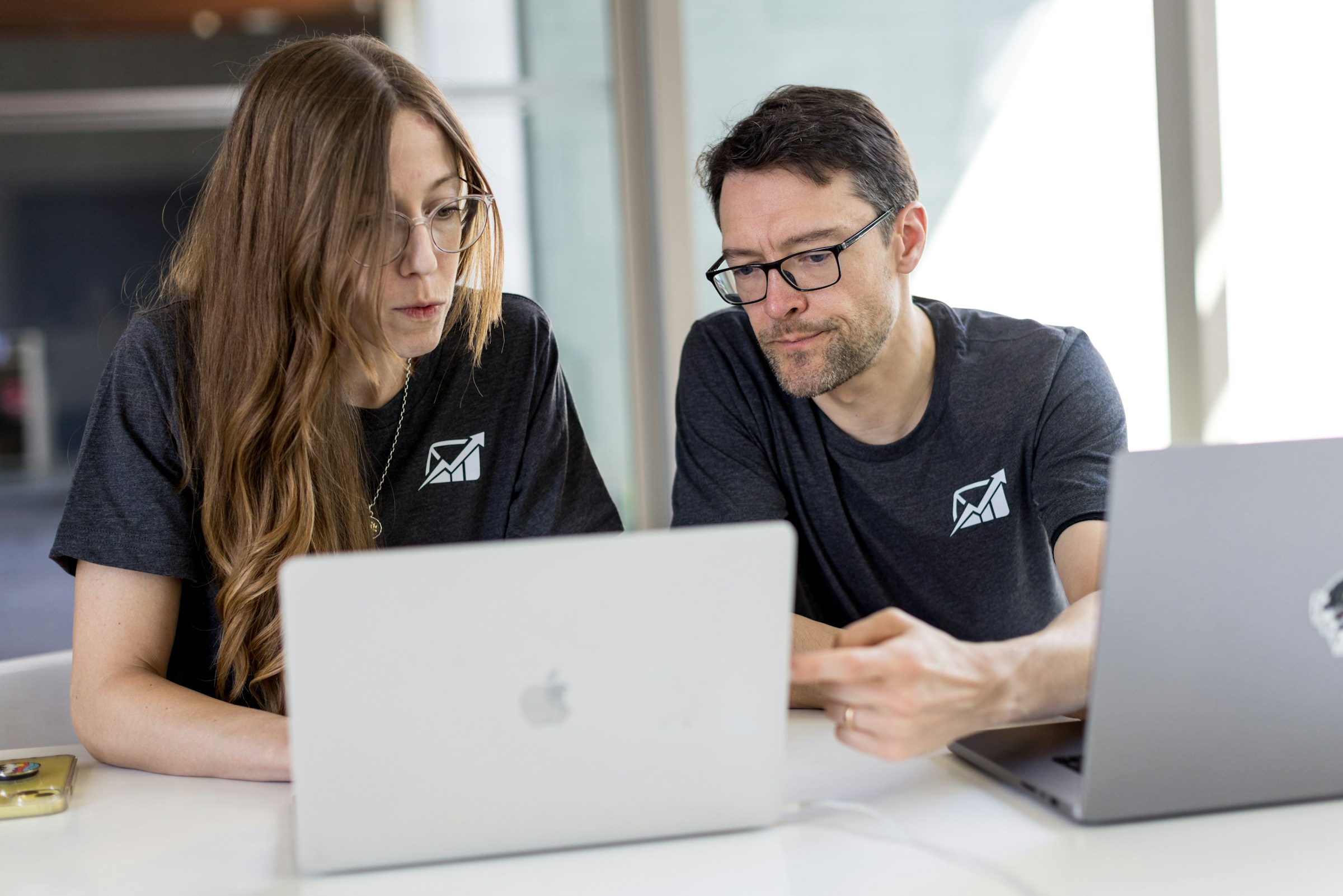You stare at a live chart late at night, wondering whether those price swings, indicators, and economic headlines mean one thing: Is Forex Trading Hard? Between currency pairs, leverage, pips, and sudden market moves, it can feel overwhelming to learn technical analysis, fundamental analysis, and risk management all at once.
When you first ask, "Is Forex Trading Hard?" you picture late nights watching charts, missed entries, and second-guessing every trade. That pressure pushes many traders toward automated Forex trading, allowing algorithmic strategies and trading bots to handle routine tasks and remove emotion from the execution process.
This guide explains how expert advisors function, how to backtest and optimize strategies, and how to manage risk, slippage, and position sizing to ensure your system behaves predictably. Ready to move from guesswork to a repeatable process?
To help with that, Goat Funded Trader's prop firm gives you access to funded accounts and a safe place to test forex robots, fine-tune indicators, and get honest market feedback without risking your own capital, so you can learn faster and trade with confidence.
Understanding Automated Forex Trading

Trading Forex manually requires a significant amount of effort, encompassing everything from analyzing charts to interpreting economic data and identifying trade setups. This process is tiring and often clouded by emotions, which can lead traders away from their best strategies. Most retail traders, between 70% and 85%, end up with losses in their accounts because of this.
Automated Forex trading aims to reduce these human errors and streamline executions.
Automated Forex trading uses software known as trading robots or expert advisors (EAs). These run on platforms like MetaTrader 4 and automatically place trades based on programmed strategies. While automation can handle trading tasks continuously and without fatigue, it does not guarantee profits or eliminate risks. Advanced EAs with sophisticated algorithms tend to be expensive or limited in availability; however, pairing good software with reliable brokers can enhance the chances of long-term success.
Many myths surround Forex robots and EAs due to misleading marketing and inflated promises. Most retail offerings are basic and don’t employ advanced technologies like machine learning or artificial intelligence. The standard strategy involves moving average crossovers, where a trade is triggered when shorter-term averages cross longer-term ones, but this simplicity has its limitations in changing market conditions.
Does automated Forex trading really work? Yes, but its success depends on the quality of its trading algorithms and how well they suit current market dynamics. Profitability often stems from exploiting fundamental market traits, such as trend following and mean reversion, which can be coded into an automated system. This means that with the right strategy, human discretion is not essential for generating profits.
The industry’s poor reputation stems mainly from a flood of scams promising quick riches. Most such systems eventually fail and deplete an account, damaging trust in automation. However, legitimate automated trading with tested strategies and proper risk management can be a valuable tool.
Popular platforms for automated Forex trading include MetaTrader 4, MetaTrader 5, NinjaTrader, TradeStation, and Interactive Brokers. Choosing the right platform often comes down to the trader’s preferred instruments, coding ability, and desired features.
Timing is critical in automated Forex trading. The best periods to run bots are when no major economic news or central bank events are expected, as these can cause unpredictable volatility. High liquidity moments, especially the overlaps between Tokyo, London, and New York trading hours, provide the smoothest trading conditions and tighter spreads.
Practical Steps to Start Automated Forex Trading
Write clear rules you can code—Backtest on high-quality tick data with realistic spread and slippage. Walk forward tests and then demo the forward test. Start small when going live and monitor performance metrics, such as profit factor, Sharpe ratio, maximum drawdown, and consecutive losses. Utilize logging and alerts to identify software faults quickly.
Monitoring, Updating, and Operational Hygiene
Track live metrics continuously and compare them with historical expectations. Keep version control, keep a changelog of parameter changes, and schedule periodic retests. Automate health checks for order fills and connectivity, and maintain backups of your code and settings to facilitate recovery from failures. Want to keep a bot running? Monitor it like you would a sensitive machine and respond quickly when performance deviates.
What are the Costs Involved in Forex Automated Trading?

Algorithmic Platform Costs
Most retail brokers bundle algorithmic trading platforms with accounts. MetaTrader, cTrader, and many proprietary platforms come with charting, strategy testers, and support for expert advisors, all at no additional platform fee.
Third-party services and institutional-grade platforms may charge subscription fees for advanced features, such as cloud backtesting, tick data, or multi-asset integration. What do you actually pay for then?
API Access Fees
Many brokers offer REST, WebSocket, or FIX-style APIs with no up-front fee, but they often attach conditions. Typical requirements include minimum deposit amounts, minimum monthly trading volumes, or restrictions on which asset classes can be traded via API.
Institutional-grade FIX connections or direct market access may incur setup fees or monthly charges, and may require completion of documentation and compliance checks. Do you need a premium API, or will the broker-provided API suffice for order execution and market data?
VPS Hosting Expenses
Brokers will often provide a Virtual Private Server when you meet deposit and volume conditions, effectively bundling hosting into the account. If you do not qualify, third-party Forex VPS providers charge from about two dollars to over fifty dollars per month, depending on latency, server region, CPU, and bandwidth.
For ultra-low-latency or high-frequency strategies, you may need colocated servers or a dedicated instance, which can incur costs of hundreds or thousands of dollars per month. How much latency can your strategy tolerate?
Internet Connectivity Cost
Automated Forex trading requires a reliable, low-latency internet connection to prevent missed orders and execution slippage. Consumer plans range from $20 to $150 per month, depending on speed and locality; adding redundancy with a secondary provider or a mobile failover increases the cost. Packet loss and jitter directly affect order fills and can change the edge in a scalping or high-frequency setup.
Developing a Trading Strategy
Designing an automated strategy requires data, tooling, and repeated testing. You factor in historical tick data for accurate backtesting, optimization runs, Monte Carlo simulations, and walk-forward testing to check robustness.
Paper trading and initial live testing typically reveal differences compared to backtests due to slippage, spread variation, and latency, and those live losses are part of the development cost. How much capital will you allocate to the live trial phase?
Cost of Coding the Strategy
Turning rules into code ranges widely in price. A basic indicator-based expert advisor using MQL4 or MQL5 might cost a few hundred dollars when outsourced. A multi-instrument system with portfolio-level risk management, robust order execution, reconciliation, and logging can cost several thousand to tens of thousands of dollars.
Suppose you incorporate machine learning, deep learning models, data engineering, and ongoing model retraining. In that case, the cost can increase to the high six figures or more, although off-the-shelf toolkits and model hosting have made advanced approaches more affordable than before. Who writes and maintains your code, and how do you test it in live market conditions
Goat Funded Trader gives you access to simulated accounts up to $800K with the most trader friendly conditions in the industry — no minimum targets, no time limits, and triple paydays with up to 100% profit split, and over 98,000 traders have collected more than $9.1 million in rewards backed by our 2 day payment guarantee with a $500 penalty for delays. Choose your path to funding through customizable challenges or start trading immediately with our instant funding options via our prop firm offering. Sign up to get access to up to $800 today with 25-30% off.
Related Reading
- What Is A Lot Size In Forex
- How Much Do You Need To Start Trading Forex
- How Profitable Is Forex Trading
- What Is Swap In Forex Trading
- Forex Trading Account Types
- How To Learn Forex Trading
- Fibonacci Forex Trading
- Pros And Cons Of Forex Trading
- Forex Trading Profit Per Day
How to Start Automated Forex Trading

Choose Your Platform
MetaTrader 4 and MetaTrader 5 are the most common choices for automated forex trading, as they both accept Expert Advisors. MT4 utilizes MQL4 and is suited for simpler EAs, whereas MT5 introduces additional order types, a built-in tester with multi-instrument support, and MQL5 for more complex algorithms. You can also use cTrader with cAlgo, broker APIs, or platforms that expose FIX or REST endpoints if you want to run Python or C# strategies.
Consider execution latency, VPS compatibility, and the quality of historical tick data that the platform supports. Ask the broker whether their servers support 24-hour EA execution, how they handle requotes, and whether their demo matches live execution. These details affect slippage, spread simulation, and real-world performance.
Build or Buy an Algorithmic Strategy
You can purchase an off-the-shelf robot, subscribe to a signal service, or develop a custom algorithm. When buying, verify the live track record, understand the logic, and check compatibility with your platform and account type. If you hire a developer, define exact entry and exit rules, risk and money management, order handling on partial fills, and how the EA reacts to economic news.
Learn the basics of MQL4, MQL5, or use a bridge to Python or C#. Keep position sizing rules, stop-loss and take-profit logic, and risk limits explicit in the code. Plan for error handling, logging, and safe start-stop procedures so that the algorithm does not behave unpredictably during connectivity issues.
Backtest the Strategy Thoroughly
Use high-quality tick data and realistic spread and commission models when backtesting. Run tests across multiple years and market regimes, including slippage simulation, and check performance with different lot sizing rules. Key metrics to monitor include profit factor, maximum drawdown, expectancy, Sharpe ratio, and percent of profitable trades.
Avoid over-optimization by reserving out-of-sample data and applying walk-forward analysis and Monte Carlo simulation to assess robustness, test sensitivity to parameter changes, and randomization of trade sequences to expose hidden weaknesses. Keep detailed logs of each backtest run for future comparison.
Pick a Broker
Select a broker with apparent regulatory oversight in a reputable jurisdiction and transparent fee structures. Check spreads, commissions, order execution speed, and whether the broker supports EAs or API trading. Execution model matters: ECN or STP execution tends to produce different slippage patterns than market maker execution.
Confirm the available account types, leverage options, and margin rules, and determine whether hedging and scalping are permitted. Test a demo account first and compare demo fills to small live trades to detect execution differences early.
Run and Monitor the Automated System
Start on a demo server and then move to a small live account once the EA performs as expected. Host the EA on a reliable VPS near the broker’s servers to minimize latency and prevent downtime. Implement automated alerts, trade logging, and an automated watchdog that pauses the robot if drawdown thresholds or connectivity errors occur.
Monitor live performance against your backtests and maintain a change log for code updates and parameter adjustments. Schedule regular reviews after significant market events and maintain control measures, such as daily risk caps and hard stops, to limit catastrophic losses.
Alternative Automated Trading Methods
If coding is not your preference, consider copy trading, social trading platforms, PAMM or MAM accounts, or subscribing to professional signal providers. Check verified performance history, provider drawdowns, and how the provider’s trade size scales to your own account. Be mindful of latency and differences in lot sizing, as these can impact realized results.
Alternatively, use broker APIs to build hybrid systems where signals come from one source and execution is handled by your broker. This approach enables you to blend custom analytics, machine learning models, or managed signals while maintaining control over execution on your account. Which approach matches your technical skills and risk tolerance?
Related Reading
- Forex Trading Candlestick Patterns
- Forex Trading Algorithms
- Risk Management In Forex Trading
- Forex Trading Day
- Minor Forex Pairs
- Forex Trading Vs Crypto Trading
- Advanced Forex Trading
- Copy Forex Trading
- Best Books On Forex Trading
- Copy Forex Trading
How to Choose the Right Automated Trading Program For You

Understanding Your Trading Goals
Decide whether you want fast day trades or steady, longer-term returns, and set measurable goals, such as a target monthly return, maximum drawdown, or annualized return. Pick a risk profile: aggressive with larger position sizes, or conservative with strict stop loss rules and small lot sizes.
Choose the level of automation you prefer — fully automatic expert advisor control or semi-automatic systems that let you intervene. Factor in capital requirements and running costs, such as subscription fees, commissions, and VPS charges, so your money management plan aligns with the program’s demands. What specific outcome will make this tool worthwhile for you in terms of money and effort?
Check the Program's Track Record
Look for real account statements that display trades, equity curves, drawdowns, and monthly returns, showing regular fluctuations. Be cautious of profit curves that appear too smooth or appear to be cherry-picked over short periods. Seek third-party verification from services like Myfxbook or FX Blue, or ask for broker-verified live accounts and audit logs.
Request clarity on how results were produced: trend following, momentum, mean reversion, breakout, grid, or scalping, and whether the results include spreads, commissions, and slippage. If the provider cannot explain the trading approach at a conceptual level, ask why and consider moving on.
Backtest, Stress Test, and Forward Test the Strategy
Run backtests on high-quality historical tick data that include realistic spreads and commission. Watch out for overfitting from aggressive parameter optimization; use walk-forward analysis and Monte Carlo simulations to estimate robustness under different market paths.
Forward test on a demo account or small live account to measure real-time slippage, latency, and execution behavior. Test across multiple market regimes, including low volatility, high volatility, and news-driven sessions, and verify how the system handles gaps and extreme events.
Match the Platform for Compatibility and Reliability
Confirm that the program supports your platform, such as MetaTrader 4, MetaTrader 5, cTrader, or direct FIX API integration. Check broker compatibility for order types, maximum lot sizes, and whether scalping or high-frequency strategies are permitted.
Inspect execution metrics: order execution speed, slippage, requotes, and server uptime. Plan to run the EA on a reliable VPS close to your broker for lower latency and stable connectivity. Verify security features, including encrypted authentication, two-factor authentication, and the safe handling of API keys and account credentials.
Trust the Trading Strategy
Understand the strategy logic enough to judge when it should work and when it will fail. Ask how the system manages risk: fixed risk per trade, volatility-based position sizing, stop loss rules, and maximum allowed drawdown. Check parameter sensitivity to determine whether small tweaks impact performance.
Confirm correlation with other positions you hold so you avoid stacking similar risks. Finally, decide if you can follow the system through inevitable losing stretches and still apply disciplined monitoring and position sizing, rather than switching strategies mid-run.
How to Choose the Best Broker for Automated Trading?

Accepting Clients Where You Live — Can They Legally and Practically Serve You?
Confirm the broker accepts traders from your country and supports local KYC and tax reporting. Regulatory restrictions often block certain nationalities or require extra paperwork. Ask the broker directly about the account opening steps, required identification, and the expected turnaround time for verification. Also, verify whether their rules limit algorithmic methods, leverage caps, or hedging for clients in your jurisdiction.
Platform Compatibility — Does Your Code Run Here?
Match the broker to the platform you use for expert advisors, scripts, or trading robots. Common choices include MetaTrader 4, MetaTrader 5, cTrader, and TradingView. If you run EAs or custom indicators, check native support for Expert Advisor deployment, Pine Script alerts, or cTrader Automate. Also, consider API access options, such as REST, WebSocket, or FIX APIs, which enable faster and more robust algorithmic integration. Confirm version compatibility and build numbers for your automated systems.
Regulation and Fund Safety — Who Watches the Broker?
Prefer brokers regulated by recognized authorities such as FCA, ASIC, CySEC, or NFA. Regulation refers to the supervision, reporting, and rules governing client money segregation. Verify the presence of negative balance protection, client fund segregation, and participation in compensation schemes, where applicable. Read the fine print on custody, bankruptcy protection, and whether the broker uses affiliated liquidity providers.
Trading Costs and How They Affect Strategy Profitability
Calculate all costs that hit algorithmic strategies: spreads, commissions per lot, overnight swap or rollover, and hidden fees like data or API charges. High-frequency systems and scalpers pay these repeatedly, so low spread plus low commission matters. Ask, for example, about trip costs at typical volumes and at different market times, such as London's opening and major news events.
Execution Quality — Speed, Slippage, and Requotes
Execution speed shapes slippage and fill quality. Ask for latency metrics, average slippage data, and historical order fill rates. Know the broker’s execution model, such as ECN, STP, or market maker, because this affects the liquidity depth and risk of requotes. If you need ultra-low latency, request co-location or server proximity options, and test using a real VPS near their servers.
Risk Controls and Order Types — Does the Broker Support Safe Automation?
Ensure support for standard order types, including stop-loss, take-profit, trailing-stop, market, and limit orders, as well as OCO logic, so your EA can effectively manage risk. Check for guaranteed stops and margin call procedures. Review the margin rules and determine whether the broker enforces FIFO constraints or prohibits hedging, as these factors significantly impact many automated trading strategies. Confirm maximum order size and number of concurrent orders per account.
Backtesting, Historical Data, and Strategy Optimization Tools
Good historical tick data and in-platform strategy tester matter for realistic backtests. Ask about tick level data, time stamps, and data continuity. See if the broker or platform offers walk-forward testing, Monte Carlo stress tests, curve-fitting checks, and parameter optimization tools. If you depend on robust backtesting, verify you can export clean tick data and run offline tests.
Execution Infrastructure — VPS, Co-location, and Connectivity Options
Automated systems benefit from uninterrupted hosting. Many brokers offer managed VPS or partner with providers. For latency-sensitive trading, co-location or colocated VPS near liquidity hubs reduces slippage and improves deterministic execution. Ask about server locations, uptime SLAs, and whether they support persistent API connections and socket reconnect logic.
Leverage, Margin Rules, and How They Impact Automated Risk
Different jurisdictions and brokers set leverage caps and margin call thresholds. High leverage amplifies both gains and drawdown risk. Confirm the margin maintenance level, stop-out rules, and whether leverage adjustments occur during periods of high volatility or news events. Make sure your money management code accounts for dynamic margin requirements.
Account Types and Execution Models — Which Fits Your Strategy?
Compare account types: micro or cent for small testing, standard for regular units, ECN or raw spread for low spread plus commission, and institutional for high volume. Ask about minimum lot size, lot step, swap rates, and whether accounts support netting versus hedging. Check if PAMM, MAM, or copy trading services are offered for scaling or fund management.
Tradable Instruments — Will Your Bot Find Enough Opportunities?
Confirm availability of the exact instruments your algorithms target: majors, minors, exotics, CFDs on indices, commodities, bonds, equities, and crypto, if needed. Liquidity varies across instruments and affects slippage and spread widenings. Review tick sizes, contract specifications, trading hours, and holiday schedules.
Demo Accounts and Sandbox Environments — Where to Test Safely
A reliable demo or sandbox environment lets you test EAs without real money. Verify that demo pricing, latency, and execution mimic live accounts and that there is access to the same APIs, margin rules, and historical data. Use the demo to validate order handling under load and during volatility, and to confirm version compatibility.
Practical Questions to Ask the Broker Right Now
Do you offer VPS or co-location services, and where are your servers located? What are your average round-trip latencies and slippage statistics? Can I access FIX or WebSocket APIs? Do you publish API documentation and sample code? Are EAs allowed in my country, and are there hedging or FIFO restrictions? What compensation or segregation mechanisms protect client funds?
Testing Checklist Before Going Live
Run a demo with identical settings to your live account, measure slippage during major sessions, test all order types, stress the system with high order rates, and backtest with tick data. Verify error handling for dropped connections and confirm how the broker handles partial fills and gap risk during news.
What to Watch for After You Start Live Trading
Monitor execution quality, realized spread costs, commission totals, and maximum drawdowns versus backtests. Monitor server uptime, log API disconnects, and track any changes to margin rules or instrument specifications. Have an emergency kill switch and backup VPS to limit runaway exposure.
Best Times to Use Automated Forex Trading

Prime Liquidity Windows
The strongest opportunities arise when sessions overlap, concentrate volume, and tighten spreads. London and New York overlap runs roughly 12:00 to 16:00 GMT. During that window, EUR/USD, GBP/USD, and USD/JPY exhibit heavy order flow and larger, reliable moves that suit scalping bots, high-frequency systems, and breakout algorithms. A shorter overlap between Tokyo and London around 07:00 to 09:00 GMT can also produce usable liquidity for JPY and AUD pairs. Have you checked which pairs your expert advisor performs best on during each session?
Steer Clear of Market-Moving Events
Automated strategies tend to perform more predictably outside of scheduled high-impact releases, such as US non-farm payrolls, central bank rate decisions, and headline geopolitical alerts. Utilize an economic calendar and integrate it into your bot as a news filter. You can code temporary trading halts, wider stop buffers, or switch order types to limit slippage during these windows. If a strategy is built explicitly for news-driven moves, run it only with low-latency execution and strict risk controls to minimize execution risk and avoid excessive trading.
Asian Sessions
The Asian session, roughly 00:00 to 09:00 GMT, tends to be quieter with more consolidation. These algorithms, which utilize mean reversion and range-bound strategies, trade crosses such as USD/JPY, AUD/USD, and NZD/USD. Expect lower volatility but wider spreads at times. Reduce position sizing and tighten execution rules for lower liquidity, or use limit orders to avoid unwanted fills. Do you monitor spread and tick density statistics for your chosen broker during these hours?
Additional Considerations
- Traders should consider local market holidays or seasonal periods, such as summer months, when liquidity often drops and spreads widen, potentially increasing trading costs and slippage.
- Automated systems benefit from being tailored to specific timeframes; shorter timeframes often suit high-frequency trades during volatile sessions, while longer timeframes align well with quieter periods for trend-following or mean-reversion strategies.
- Consistent backtesting and system optimization aligned with these time periods enhance the reliability of automated trading performance.
How often do you retest your system against recent market regimes?
Related Reading
- Forex Options Trading Strategy
- Best Laptop For Trading Forex
- Forex Trading Course For Beginners
- Forex Trading App For Beginners
- How To Choose The Best Forex Broker
- Best Forex Pairs To Trade During New York Session
- Forex Trading Strategies For Beginners
- Forex Algorithmic Trading Strategies
- Best Forex Pairs For Beginners
Get 25-30% off Today - Sign up to Get Access to Up to $800K Today

Goat Funded Trader gives access to simulated accounts up to $800K with the most trader-friendly conditions in the industry. There are no minimum targets or time limits, plus triple paydays with a potential 100 percent profit split. Join over 98,000 traders who have already collected more than $9.1 million in rewards. Payments clear fast under our 2-day payment guarantee with a $500 penalty for delays. Choose your path to funding through customizable challenges or start trading immediately with our instant funding options. Sign up to get access to up to $800K today and receive 25 to 30 percent off. Ready to test automation on a funded simulated account?
How to Use Simulated Funding to Reduce Automation Risk
Simulated accounts let you replicate live conditions without risking your capital. Use them to validate execution latency, to measure slippage under realistic spreads, and to test broker-specific order types. Run your expert advisor against the funded account rules so you see how drawdown limits and profit distributions behave. Pair the simulated account with a VPS near the broker servers and a stable data feed so you can reproduce live timing. Will you treat the simulated account as a final gate before live deployment?
Pricing and Payout Mechanics for Funded Accounts
Look at profit split cadence and withdrawal rules. Goat Funded Trader offers triple paydays and a profit split of up to 100 percent on qualified accounts. Payment speed matters when you scale. The two-day payment guarantee, accompanied by a $500 penalty for delays, fosters trust in payouts. Some traders prefer customizable challenges to prove their strategy. Others take instant funding to start trading live immediately. Which payout cadence matches your plan for compounding?
Where to Start with Automated Forex Trading Today
Select a platform that aligns with your skill set and toolchain, such as MT4, MT5, or cTrader. Get clean historical tick data and a VPS close to your broker. Build a minimum viable strategy, thoroughly backtest it, and then forward-test on a simulated account that mirrors the rules you will face in funding. Use money management and alerts from day one. Consider leveraging Goat Funded Trader to scale validated strategies and to remove account funding as a bottleneck. Want help mapping a step-by-step plan for your first automated system?
.svg)
.avif)



.avif)





.svg)

.svg)